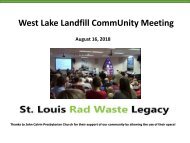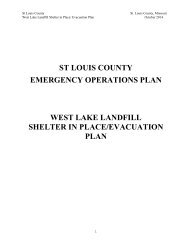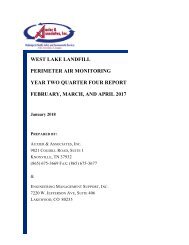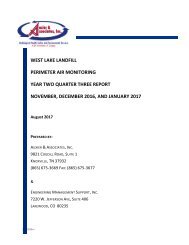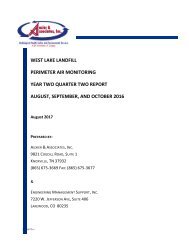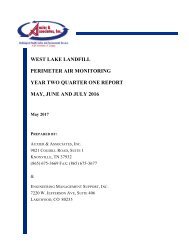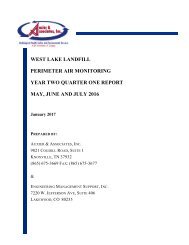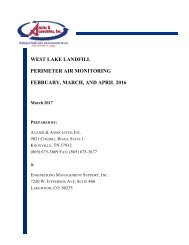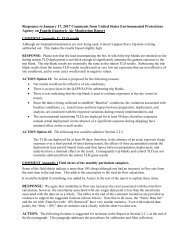CAG Board Comments on Proposed Remedy for West Lake Landfill April 18 2018
The Community Advisory Group (CAG) submits the following comments and we are including a copy of our submission to the NRRB as part of our public comment in response to the Environmental Protection Agency’s (EPA) public comment period for its Proposed Remedy at the West Lake Landfill Operable Unit 1 (OU-1).
The Community Advisory Group (CAG) submits the following comments and we are including a copy of our submission to the NRRB as part of our public comment in response to the Environmental Protection Agency’s (EPA) public comment period for its Proposed Remedy at the West Lake Landfill Operable Unit 1 (OU-1).
You also want an ePaper? Increase the reach of your titles
YUMPU automatically turns print PDFs into web optimized ePapers that Google loves.
BOARD COMMENTS ON PROPOSED REMEDY FOR WEST LAKE LANDFILL<br />
<strong>April</strong> <strong>18</strong>, 20<strong>18</strong><br />
covered! Covering of surface c<strong>on</strong>taminati<strong>on</strong> <strong>on</strong>ly occurred last year, yet the wind has been<br />
blowing since be<strong>for</strong>e the surface c<strong>on</strong>taminati<strong>on</strong> was acknowledged.<br />
We stand with the residents living within approximately <strong>on</strong>e mile of the site who request<br />
voluntary relocati<strong>on</strong>. We also believe that <strong>for</strong> those within two miles of the site who will remain<br />
in their homes, property value assurance must be part of the agreement.<br />
A commitment is essential to area residents who live within these defined perimeters and have<br />
suffered from health and safety issues, odor effluence and the devaluati<strong>on</strong> of property. As much<br />
as possible, we believe that these residents deserve these opti<strong>on</strong>s which, <strong>for</strong> the first time since<br />
the harmful nature of the site was uncovered, will give them some modicum of c<strong>on</strong>trol over the<br />
circumstances of their lives, which have been put in harm's way through no fault of their own.<br />
We know from the health survey that people living closest to the landfill are statistically more<br />
likely to suffer from shortness of breath and are c<strong>on</strong>siderably more likely to be c<strong>on</strong>cerned about<br />
odors impacting their lives daily. These are real people with respiratory problems living near the<br />
landfill that are being advised by the DHSS that “during periods of objecti<strong>on</strong>able odor, sensitive<br />
individuals should stay indoors as much as possible, avoid outdoor exercise, and seek medical<br />
advice <strong>for</strong> any acute symptoms.”<br />
Not knowing when the next odor attack will occur or how the chr<strong>on</strong>ic exposure to low-level<br />
c<strong>on</strong>taminants being released by the landfill has and is impacting their health results in chr<strong>on</strong>ic<br />
stress <strong>for</strong> many fence-line families. Chr<strong>on</strong>ic stress, itself, has a proven impact <strong>on</strong> human health,<br />
leading to increased risk <strong>for</strong> cardiovascular disease, depressi<strong>on</strong>, and autoimmune disease,<br />
am<strong>on</strong>g other health problems. The combinati<strong>on</strong> of physical and mental impacts from the odor at<br />
the landfill has led to a reduced quality of life and increased risk of illness <strong>for</strong> the people who<br />
live closest to the landfill.<br />
2. St. Louis County Department of Emergency Management, Patt<strong>on</strong>ville Fire District, and a<br />
representative from our community should be included in meetings and deliberati<strong>on</strong>s during the<br />
design and engineering phase.<br />
3. During c<strong>on</strong>structi<strong>on</strong> and any field tests, St. Louis County Department of Emergency Management<br />
and Patt<strong>on</strong>ville Fire District should each, independently, be granted the right to inspect the site at<br />
any time and be given the authority to stop work at any time they deem a risk to the public or<br />
workers has or is about to occur.<br />
4. We c<strong>on</strong>tinue to be c<strong>on</strong>cerned that EPA has issued a <strong>Remedy</strong> without knowing where all the RIM is<br />
located, i.e., the North Quarry has not been fully tested: indeed, the <strong>on</strong>ly testing <strong>for</strong> soil based RIM<br />
in the North Quarry was per<strong>for</strong>med in order to find a suitable locati<strong>on</strong> <strong>for</strong> an isolati<strong>on</strong> barrier that<br />
was ordered by both the Missouri Attorneys General and the EPA. Once it was determined that the<br />
Northern end of the North Quarry was too deep <strong>for</strong> an isolati<strong>on</strong> barrier to be installed, testing was<br />
stopped, leaving a large percentage of the landfill untested and NOT included in the <strong>Proposed</strong><br />
<strong>Remedy</strong> or any of the Alternatives evaluated. This is of particular c<strong>on</strong>cern since this is the area<br />
between the “known RIM” and the current SSE AND an area that has experienced landfill fires<br />
even closer to the “known RIM” than the current SSE.<br />
Page 2 of 6



